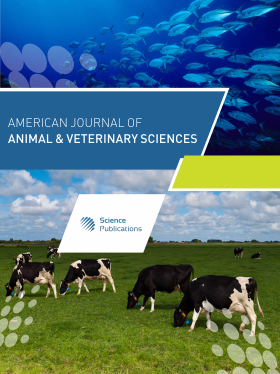Assessment of Immunogenicity of CP8, CLFA-FnBPB and CP8-CLFA-FnBPB Antigens
- 1 Inner Mongolia Agricultural University, China
- 2 Lethbridge Research Centre, Canada
Abstract
To assess the effects of conjugating Capsular Polysaccharide (CP) with Clumping factor A (ClfA) and Fibronectin-Binding Proteins B (FnBPB) on the immunogenicity of the antigen, CP was isolated and purified from serotype 8 (CP8) Staphylococcus aureus from bovine mastitis dairy herds in Inner Mongolia and ClfA-FnBPB was produced with Escherichia coli encoding a fusion protein ClfA-FnBPB gene. The CP8-ClfA-FnBPB complete antigen was constructed by first attaching Alcohol Dehydrogenase (ADH) to CP8 which was then combined with ClfA-FnBPB at the presence of EDC (1-ethyl-3, (3-di-methylaminopropyl carbodiimide). The immunogenicity of CP8, ClfA-FnBPB and CP8- ClfA-FnBPB was determined by intraperitoneal injecting 40 8-wk old of Balb/c mice four groups with 0.2 mL/mouse of 0.9% NaCl (Control) or CP8, ClfA-FnBPB and CP8-ClfA-FnBPB solution. The mice were group-fed with same pellet diet in an environmentally controlled room with a constant temperature of 22°C and 12h/24h light. The concentration of CP8, ClfA-FnBPB or CP-ClfA-FnBPB in respective solutions was 50, 25 or 75 µg mL-1. Two injections were given, on d7 and d21 of the experiment. Blood samples were taken on d0, d14, d21 and d28 and measured for the antibodies titer. On d28, all mice were injected with CP8 type of S. aureus and the mortality of the mice determined for the following 14 days (challenge test). The results showed that ClfA-FnBPB was successfully expressed by E coli and the isolated and purified ClfA-FnBPB was successfully conjugated with CP8 to yield a CP8-ClfA-FnBPB complete antigen. Mice immunized with CP8-ClfA-FnBPB had higher antibody titer than that of CP8 (p<0.01) and ClfA-FnBPB (p<0.05) groups. Antibody titer in mice immunized with ClfA-FnBPB antigen was also higher (p<0.05) than that of CP8 and 0.9% NaCl groups. Survival rate of the mice at the end of 2-wk challenge test for Control, CP8, ClfA-FnBPB and CP8-ClfA-FnBPB groups were 20 30, 60 and 80% respectively. These results demonstrated that conjugating CP8 with ClfA-FnBPB to form CP8-ClfA-FnBPB complete antigen significantly increased immunogenicity of the antigen and markedly enhanced the survival rate of the mice infected with the bacteria. The information suggests that vaccine based on the CP8-ClfA-FnBPB antigen would be more effective in controlling bovine mastitis than those based on CP8 and ClfA-FnBPB alone, but further animal study is needed.
DOI: https://doi.org/10.3844/ajavsp.2013.134.141

- 5,935 Views
- 5,541 Downloads
- 1 Citations
Download
Keywords
- S. Aureus
- Capsular Polysaccharide
- CP8-ClfA-FnBPB
- Immunogenicity Mice
